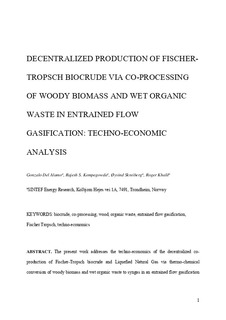| dc.contributor.author | del Alamo Serrano, Gonzalo | |
| dc.contributor.author | Kempegowda, Rajesh Shivanahalli | |
| dc.contributor.author | Skreiberg, Øyvind | |
| dc.contributor.author | Khalil, Roger Antoine | |
| dc.date.accessioned | 2019-10-07T08:49:31Z | |
| dc.date.available | 2019-10-07T08:49:31Z | |
| dc.date.created | 2017-05-11T09:14:37Z | |
| dc.date.issued | 2017 | |
| dc.identifier.citation | Energy & Fuels. 2017, 31 (6), 6089-6108. | nb_NO |
| dc.identifier.issn | 0887-0624 | |
| dc.identifier.uri | http://hdl.handle.net/11250/2620557 | |
| dc.description.abstract | The present work addresses the techno-economics of the decentralized coproduction of Fischer-Tropsch biocrude and liquefied natural gas via thermochemical conversion of woody biomass and wet organic waste to syngas in an entrained flow gasification reactor. The process design considers thermal pretreatment of the feedstock based on integrated drying of both the woody biomass and the organic waste using direct-contact superheated steam, and torrefaction for the dried wood. The superheated steam required for drying is produced from recovery of residual heat from the main conversion process. The overall cost of biocrude production has been shown to decrease when increasing the fraction of organic waste when considering gate fees for the organic waste, at the production site, above 10$/ton. For gate fees of 50$/ton, which are realistic for the current waste market, the cost of biocrude ranges between 25 and 22$/GJ for plant scales between 150 and 600 MW based on the input feedstock energy to the entrained flow gasification. Although the sludge has lower calorific value and higher moisture content, which require higher capital investment for pretreatment, the reduction of feedstock supply cost with increasing fraction of sludge becomes dominant in evaluating the overall cost of production. Moreover, the overall efficiency for biocrude and LNG production, and therefore the main income to the plant, is comparable for mass fractions of the sludge in the raw feedstock ranging between 0 and 50%. Based on direct-contact superheated steam dryers for the pretreatment of sludge, the residual heat recovered from the main conversion process is sufficient to coprocess up to 50% mass fraction of sludge in the raw feedstock with moisture content up to 80%. © 2017 American Chemical Society. | nb_NO |
| dc.language.iso | eng | nb_NO |
| dc.publisher | ACS | nb_NO |
| dc.rights | Attribution-NonCommercial-NoDerivatives 4.0 Internasjonal | * |
| dc.rights.uri | http://creativecommons.org/licenses/by-nc-nd/4.0/deed.no | * |
| dc.title | Decentralized Production of Fischer-Tropsch Biocrude via Coprocessing of Woody Biomass and Wet Organic Waste in Entrained Flow Gasification: Techno-Economic Analysis | nb_NO |
| dc.type | Journal article | nb_NO |
| dc.type | Peer reviewed | nb_NO |
| dc.description.version | acceptedVersion | nb_NO |
| dc.source.pagenumber | 6089-6108 | nb_NO |
| dc.source.volume | 31 | nb_NO |
| dc.source.journal | Energy & Fuels | nb_NO |
| dc.source.issue | 6 | nb_NO |
| dc.identifier.doi | 10.1021/acs.energyfuels.7b00273 | |
| dc.identifier.cristin | 1469507 | |
| dc.relation.project | Norges forskningsråd: 244069 | nb_NO |
| dc.relation.project | Norges forskningsråd: 257622 | nb_NO |
| cristin.unitcode | 7548,70,0,0 | |
| cristin.unitname | Termisk energi | |
| cristin.ispublished | true | |
| cristin.fulltext | postprint | |
| cristin.qualitycode | 2 | |

